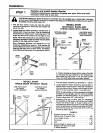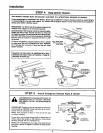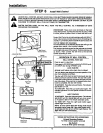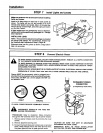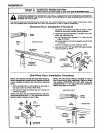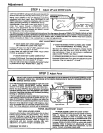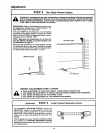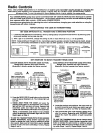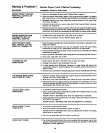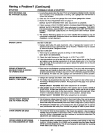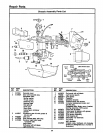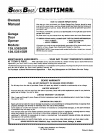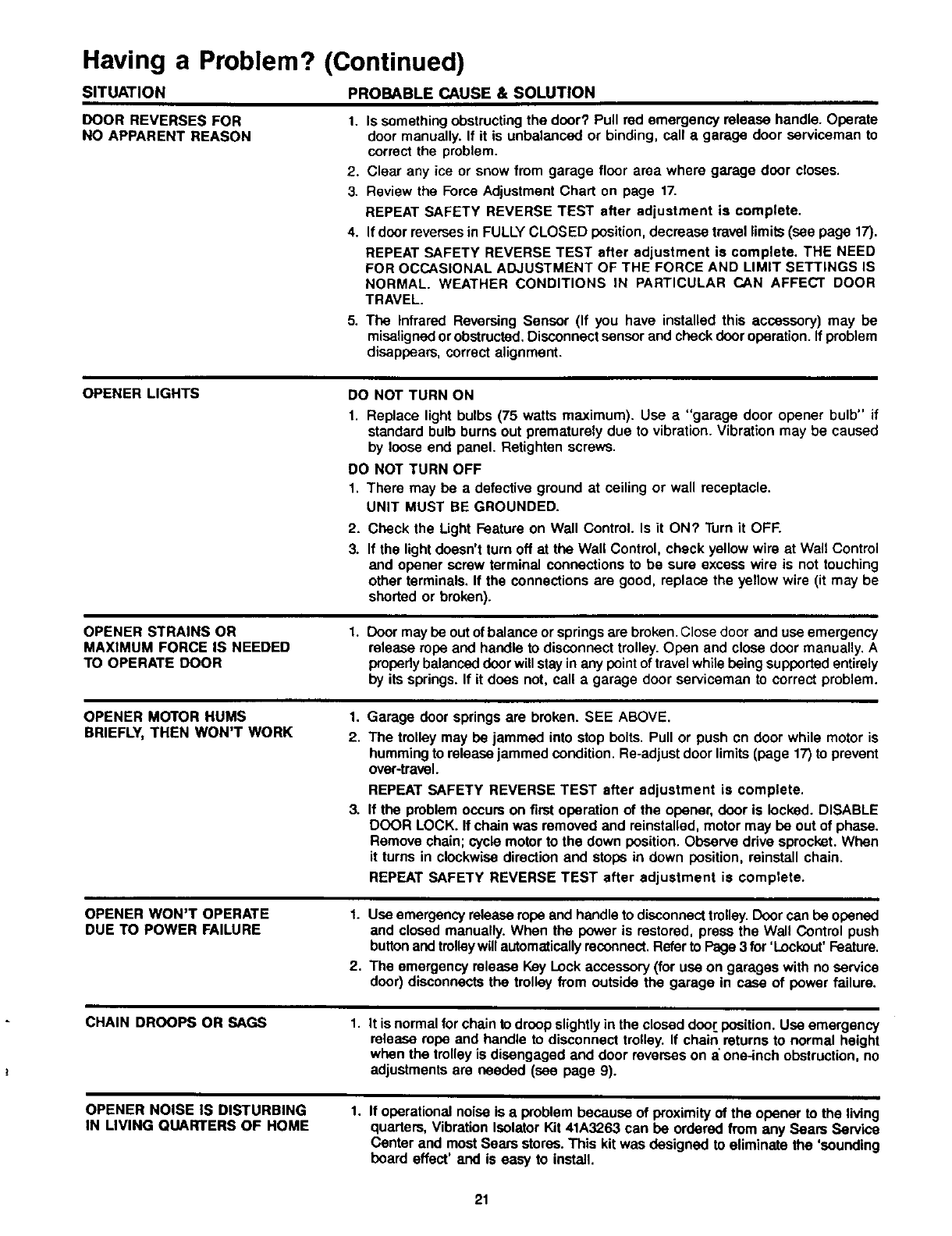
Having a Problem? (Continued)
SITUATION PROBABLE CAUSE & SOLUTION
DOOR REVERSES FOR
NO APPARENT REASON
1. Is something obstructing the door? Pull red emergency release handle. Operate
door manually. If it is unbalanced or binding, call a garage door serviceman to
correct the problem.
2. Clear any ice or snow from garage floor area where garage door closes.
3. Review the Force Adjustment Chart on page 17.
REPEAT SAFETY REVERSE TEST after adjustment is complete.
4. If door reverses in FULLY CLOSED position, decrease travel limits (see page 17).
REPEAT SAFETY REVERSE TEST after adjustment is complete. THE NEED
FOR OCCASIONAL ADJUSTMENT OF THE FORCE AND LIMIT SETTINGS IS
NORMAL. WEATHER CONDITIONS IN PARTICULAR CAN AFFECT DOOR
TRAVEL.
5. The Infrared Reversing Sensor (If you have installed this accessory) may be
misaligned or obstructed. Disconnect sensor and check door operation. If problem
disappears, correct alignment.
OPENER LIGHTS
DO NOT TURN ON
1. Replace light bulbs (75 watts maximum). Use e "garage door opener bulb" if
standard bulb burns out prematurely due to vibration. Vibration may be caused
by loose end panel. Retighten screws.
DO NOT TURN OFF
1. There may be a defective ground at ceiling or wall receptacle.
UNIT MUST BE GROUNDED.
2.
3.
Check the Light Feature on Wall Control. Is it ON? Turn it OFF.
If the light doesn't turn off at the Wall Control, check yellow wire at Wall Control
and opener screw terminal connections to be sure excess wire is not touching
other terminals. If the connections are good, replace the yellow wire (it may be
shorted or broken).
OPENER STRAINS OR
MAXIMUM FORCE IS NEEDED
TO OPERATE DOOR
1.
Door may be out of balance or springs are broken. Close door and use emergency
release rope and handle to disconnect trolley. Open and close door manually. A
properly balanced door will stay in any point of travel while being supported entirely
by its springs. If it does not, call a garage door serviceman to correct problem.
OPENER MOTOR HUMS
BRIEFLY, THEN WON'T WORK
1.
2.
3.
Garage door springs are broken. SEE ABOVE.
The trolley may he jammed into stop bolts. Pull or push cn door while motor is
humming to release jammed condition. Re-edjust door limits (page 17)to prevent
over-travel.
REPEAT SAFETY REVERSE TEST after adjustment is complete.
If the problem occurs on first operation of the opener, door is locked. DISABLE
DOOR LOCK. If chain was removed and reinstalled, motor may be out of phase.
Remove chain; cycle motor to the down position. Observe drive sprocket. When
it turns in clockwise direction and stops in down position, reinstall chain.
REPEAT SAFETY REVERSE TEST after adjustment is complete.
OPENER WON'T OPERATE
DUE TO POWER FAILURE
1. Use emergency release rope and handle to disconnect trolley. Door can be opened
and closed manually. When the power is restored, press the Wall Control push
button and trolleywillautomatically reconnect. Refer to Page 3 for'Lockout' Feature.
2. The emergency release Key Lock accessory (for use on garages with no service
door) disconnects the trolley from outside the garage in case of power failure.
CHAIN DROOPS OR SAGS
It is normal for chain to droop slightly in the closed door. position. Use emergency
release rope and handle to disconnect trolley. If chain returns to normal height
when the trolley is disengaged and door reverses on a"one-inch obstruction, no
adjustments are needed (see page 9).
OPENER NOISE |S DISTURBING
IN LIVING QUARTERS OF HOME
1.
If operational noise is a problem because of proximity of the opener to the living
quarters, Vibration Isolator Kit 41A3263 can be ordered from any Sears Service
Center and most Sears stores. This kit was designed to eliminate the 'sounding
beard effect' and is easy to install.
21




